Lower Body Stretches


Use these lower body stretches for your quads, glutes, hamstrings and more. Stretching your muscles helps prevent injury and lengthens the muscles for a toned body.
These illustrated stretching exercises include step by step instructions and pictures to help you ensure you are doing them correctly.
These stretches are a great way to lengthen, strengthen and tone your lower half. As with any exercise, make sure to do it correctly in order to minimize risk of injury and to properly stretch the muscles.
Lower Body Stretches List
You can use the links below to go directly to a specific stretching move or simply scroll through this page.
Lower Body Stretches - Glute Stretch
The glute stretch is just one of several lower body stretches you will perform with this series. After a great workout you want to make sure you cool down and stretch out your muscles. Just as important as cooling down, you also want to warm up the muscles and give them a good stretch before any sports or aerobic exercises.
Your gluteal muscles are a group of four different muscles. Three of these are located in the buttocks. These include the gluteus maximus, medius and minimus. The fourth, and smallest, is the tensor fasciae latea muscle that is located anterior and lateral to the other three glute muscles.
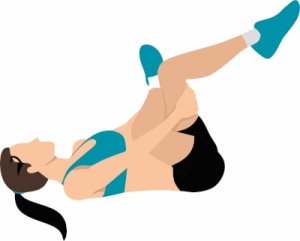
How to do the Glute Stretch
- Lie down on your back with knees bent at a 90 degree angle.
- Cross the left leg over the right leg just above the knee.
- Grab your right leg on the back of the thighs.
- Using your arms, pull in gently until you start to feel the stretch in your butt area.
- Hold this stretch from 20 to 30 seconds.
- Repeat with the other leg.
Lower Body Stretches - Hip Flexor Stretch
As the name suggests, this lower body stretch will be stretching the hip flexors. These are located in the front of the hips just above the thighs. They are responsible for hip flexion which means bringing the thigh up towards the stomach.
As with any stretches, you want to make sure you warm up your muscles first. So if you are just starting your workout, do a quick 3 - 5 minute warm up. Then stretch the muscles to help prepare them for the workout.
How to do the Hip Flexor Stretch
You will be kneeling on the floor for this stretch. So find a pillow or fold up a towel to protect your knee.
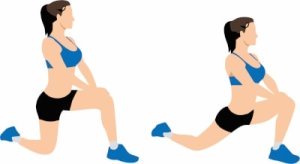
- Place your right knee on the pillow or towel.
- Place your left foot on the ground in front of you with the leg bent at a 90 degree angle.
- Slowly lean forward until you feel the stretch.
- Hold this stretch from 20 to 30 seconds. Repeat the stretch several times.
- Repeat with the other leg.
Lower Body Stretches - Outer Thigh Stretch
This next stretch is for the outer thigh. This muscle runs along the outer leg from your hip down to the knee. You use this muscle whenever you are moving your leg away from the center like when stepping sideways, playing sports and other activities.
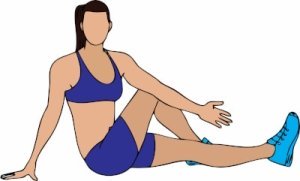
How to do the Outer Thigh Stretch
- Sit on an exercise mat with your left leg straight out in front of you.
- Take your right leg and bend it at the knee and over the straight leg.
- Your body should be facing forward with the left leg straight and the right leg bent at the knee as shown in the illustration.
- Place your right hand on the floor next to your body.
- Take your left arm and place it on your right knee, twisting your body slightly.
- Push slightly with your left arm until you feel the stretch on the outer thigh.
- Hold this stretch for 20 to 30 seconds.
- Repeat for the other leg.
Lower Body Stretches - Inner Thigh Stretch
This moves shows how to do an inner thigh stretch. The adductors are the inner thigh and groin muscles. Keeping this area stretch can help minimize injuries from every day activities. As with the outer thighs, the inner thighs run the length of the knee up to the hip area on the inside of the legs.
If you are planning an aerobic workout, which generally requires movement of the legs, then be sure to do a quick warm up and stretch first. This will help prepare your muscles for a great workout.
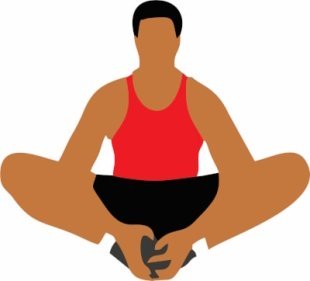
How to do the Inner Thigh Stretch
- Sit on the floor with your back, butt and head up against a wall or simply sit straight up.
- Place your legs straight out in front of you.
- Bring your legs toward your body keeping your feet together.
- Grab your ankles with both hands.
- Pull your heels towards your groin as you push your knees towards the ground.
- Hold this stretch for 30 - 60 seconds.
Lower Body Stretches - Calf Stretch
This lower body stretch are instructions for the calf stretch. The calf muscle is located at the back of the lower leg. There are actually two muscles making up the calves.
The first is the gastrocnemius and the other is the soleus muscle. These two muscles taper and merge together at the calf. While walking, running or jumping, this muscle pulls the heel up and allows forward movement.
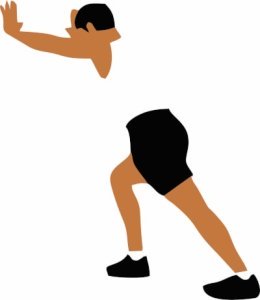
How to do the Calf Stretch
There are many different stretches you can do for the calf muscle. The directions and illustration below is for a standing wall stretch for the calves.
- Stand one to two feet away from (and facing) the wall placing your hands on the wall.
- Place the toes of your right foot up against the wall.
- Press the heel of your right foot on the ground.
- Keep both legs straight. Push your hips forward to deepen the stretch.
- Hold this stretch for 20 - 30 seconds.
- Repeat for the other leg.
Lower Body Stretches - Hamstring Stretch
This stretch targets the hamstrings, which are a group of muscles located at the back of the upper leg. These muscles are the biceps femoris, semitendinosus and the semimembranosus muscles. Together they help with many different things but are primarily used for flexion (or bending) of the knee.
They also assist in moving the upper leg backwards by extending the thighs. The hamstrings help with maintaining a standing position with knees slightly bent, as well as limiting how far we can bend over without bending the knees. Lastly, this group of muscles helps with our posture by assisting to straighten out the lower curvature of the spine.
How to do the Hamstring Stretch
You will be lying down for this stretch so use an exercise mat to be comfortable.
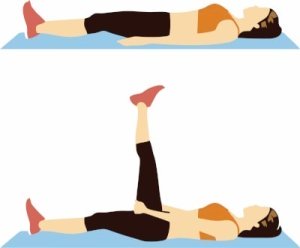
- Lie down on your back with your legs stretched out in front of you.
- Lift your right knee up slowly and grab the back of your thigh just below the knee and pull it towards your chest.
- Relax your arms a bit until the knee is pointing straight up towards the ceiling.
- Now straighten your right leg up to the ceiling and hold for 10 to 15 seconds.
- Bend your knee to return to the starting position. Hold for a few seconds.
- Repeat the stretch again for 10 to 15 seconds by straightening the leg again. Do 3 - 4 more times on this leg
- Repeat for the other leg.
Lower Body Stretches - Quadricep Stretch
The quadricep stretch is the last of these lower body stretches on this pageseries. The quadriceps are a four headed muscle that are located in the front of the upper leg (your thighs). These are the Vastus Medialis, Intermedius and Lateralis and finally the Rectus Femoris.
The primary purpose of the quadricep is to extend the knee joint. This is used everytime you walk, jog, run, sit, climb stairs or even jump. Keeping this muscle group healthy by strengthening and stretching ensures you can perform everyday tasks.
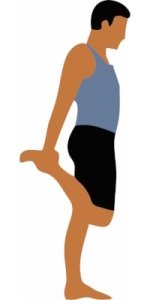
How to do the Quadricep Stretch
This is a standing stretching move so no mat is required.
- Stand with your feet together.
- Lift your right leg bending at the knee and grab onto your foot bringing your heel up towards the buttocks.
- Keep your back straight and pull your leg back and up to feel the stretch.
- Hold this stretch for 20 seconds or longer.
- Repeat for the other leg.
Tips for Stretching
Stretching for just 10 minutes each day helps improve balance, flexibility and strength. Before beginning any stretching your muscles must first be warmed up. You can do this by simply walking or jogging in place for 5 to 10 minutes. If your muscles are cold and not prepared you could cause injuries to them.
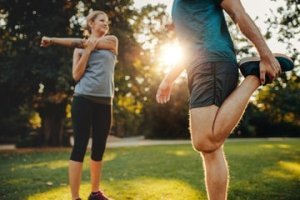
Never over stretch to the point of creating tears in the muscles. It's okay to deepen the stretch, but only to the point you feel mild discomfort and are not putting stress on the muscles.
You want to hold the position and not pulse or bounce the move. When you bounce you risk over stretching the muscles which can strain the muscles.
Remember to breathe while you do your routine. You want to keep the muscles oxygenated. Try to work opposing muscle groups with your stretching routine.
If you have had any recent injuries or are just starting out, you might need to check with your doctor first. After you have completed these lower body stretches, try some lower body strengthening using dumbbell weights.
Additional Articles
Benefits of Warming Up
In addition to your stretches you should warm up before your
exercise routine. Find out here why warming up is beneficial to
your workout.
Eating After Exercise
Find out what foods you should eat to refuel your body after your
workout.
Upper Body Stretches
Tone the upper body muscles with these stretching exercises.
